| Part of a series on the |
| Culture of Iran |
|---|
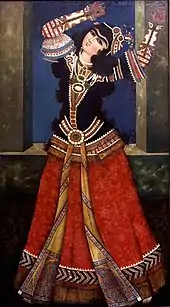 |
|
|
Iranian handicrafts are handicraft or handmade crafted works originating from Iran.
Basketry and wickerwork
- Boryabaf, a bamboo wickerwork or textile, used to make floor mats, stools, and fans.
- Kapu (basket), a palm leaf basketry.[1]
- Tutan (boat), an indigenous boat made of tobacco leaves found in the Hamun Lake region[2]
Carpets and rugs
- Persian carpet
- Abadeh rug, type of carpet with a large diamond pattern
- Afshar rugs, carpets from the Turkic Afshar tribe
- Ardabil Carpet, the name of two different famous Safavid carpets which became a style[3]
- Dilmaghani, the oldest existing manufacturers of hand knotted carpets
- Gabbeh, a type of Persian nomadic carpet
- Heriz rug, type of carpet with copper in the wool and bold patterns with a large medallion
- Shiraz rug, a type of Persian carpet
- Tabriz rug, genre of carpets found in Tabriz
- Kilims, flat woven rug or tapestry[4]
- Zili, type of Kilim
- Soumak, flat woven rug, bedding, or tapestry; a stronger and thicker weave than a Kilim
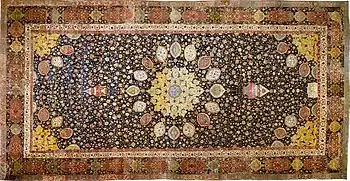 The Ardabil carpet
The Ardabil carpet weaving a carpet in a caravansari in Meybod
weaving a carpet in a caravansari in Meybod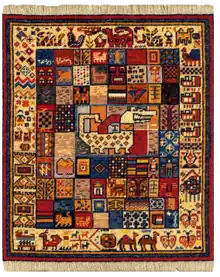 gabbeh carpet
gabbeh carpet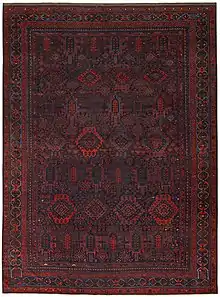 Baluch carpet, mid–19th century
Baluch carpet, mid–19th century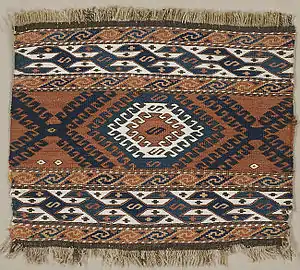 Soumak rug
Soumak rug
Textiles
- Persian embroidery
- Pateh, needlework on wool, with colored thread, mostly of silk. It is mostly created by women.[5]
- Rasht embroidery
- Sermeh embroidery
- Sistan embroidery and Sistan cream embroidery, using a black, cream or white thread color to decorate clothing or other fabrics
- Zardozi, metal embroidery thread work made of silver or gold.[6]
- Balochi needlework
- Brocade, shuttle-woven fabrics often made in colored silks and sometimes with gold and silver threads.
- Felt, a traditional weaving, common to the Kermanshah province[7]
- Ghelimche, a traditional machine woven fabric
- Ghalamkar, wood-block printed fabric, often used for table cloths or as bedspreads.[8]
- Khameh, silk embroidered on raw-colored fabric, typically in all white.[9]
- Jajim, hand-woven, colorful fabric often found in rural areas
- Termeh, hand woven fabric, often used for table cloths, or made into shawls.[10]
_Embroidery_Cushion_Covers.jpg.webp) Up-close of Zardozi metal embroidery
Up-close of Zardozi metal embroidery A sample of Termeh
A sample of Termeh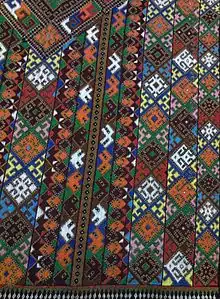 Iranian Baluchi embroidery
Iranian Baluchi embroidery Persian silk brocade fabric with silver thread (Persian: Golabetoon)
Persian silk brocade fabric with silver thread (Persian: Golabetoon) Bakhtiari felting in Shahr-e Kord
Bakhtiari felting in Shahr-e Kord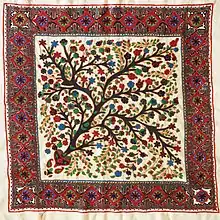 Pateh, needlework on wool
Pateh, needlework on wool
Metalwork
- Dovatgari[11][12]
- Enamelwork (Persian: Minakari)[13]
- Metal engraving (Persian: Ghalamzani)[13]
- Openwork, a popular style for bronze work
- Silver-gilt
- Toreutics (Persian: Ghalam-Zani)[14]
 Tabriz-style copper
Tabriz-style copper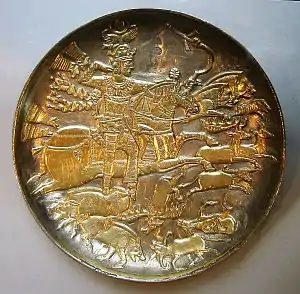 Persian metal engraving (golden plated), depicting Shah Anushirvan
Persian metal engraving (golden plated), depicting Shah Anushirvan ring making in Qom province
ring making in Qom province Openwork metal, incense burner, c. 11th century
Openwork metal, incense burner, c. 11th century Enamelwork
Enamelwork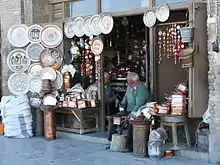 Store selling metalwork
Store selling metalwork
Woodwork
- Girih, a branch of traditional architecture and tiling strapwork, often made of wood, but sometimes made of other materials.
- Moarragh (also known as Moarraq), traditional marquetry or wood inlay
- Khatam, marquetry or wood inlay using very small pieces, often made into boxes or to decorate home goods[15][13]
- Wood carving
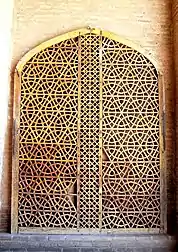 Girih screen found in Nishapur
Girih screen found in Nishapur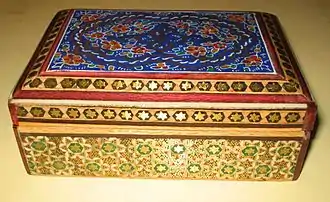 A sample of Khatam box
A sample of Khatam box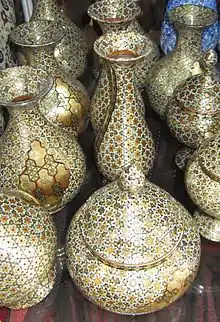 Khatam items
Khatam items
Pottery and ceramics
- Earthenware
- Fritware
- Garrus ware
- Gombroon ware
- Kraak ware
- Kubachi ware
- Lustreware
- Mina'i ware
- Moarragh, traditional ceramic mosaic tile developed by the Seljuks[16][17]
%252C_piatto_con_uccello_tra_fiori%252C_1580-1630_ca..JPG.webp) Persian Kraak ware
Persian Kraak ware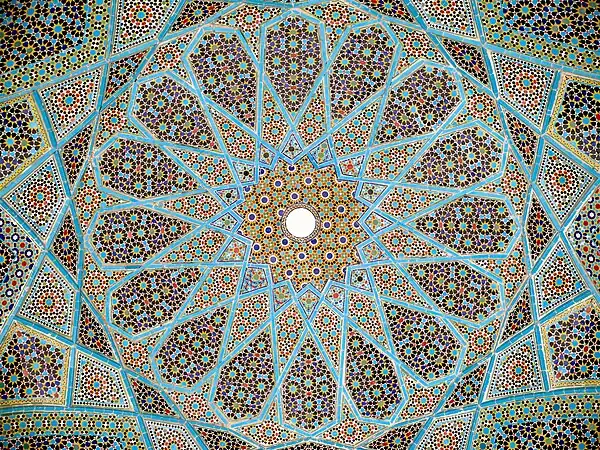 glazed ceramic tile work, from the ceiling of the Tomb of Hafez in Shiraz
glazed ceramic tile work, from the ceiling of the Tomb of Hafez in Shiraz_-_XVII_i%C3%A8me_si%C3%A8cle_-_Inventaire_AR_2005-22_(cropped).JPG.webp)
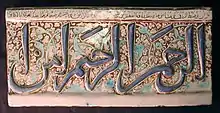
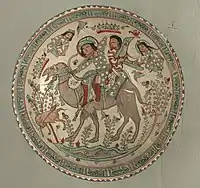
Stone, masonry, and mosaic
- Chiq, a building material used inside the walls of nomadic black tents called "siah chador".[18]
- Hardstone carving
- Sculpturing
- Stained glass
- Firoozeh Koobi, made of a copper vessel that is covered with inlayed turquoise stone.[19]
- Stone inlay, the most popular stone used is carnelian, followed by turquoise to make traditional jewelry.[20] The inlay is typically laid in mastic and wax, then fixed with enamel and/or niello.[20]
.png.webp) Firoozeh koobi or Persian turquoise inlay
Firoozeh koobi or Persian turquoise inlay Colossal Statue of Shapur I, example of traditional statuary stone carving
Colossal Statue of Shapur I, example of traditional statuary stone carving Enameled vase
Enameled vase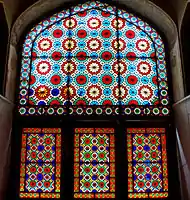
Painting, drawing, and motifs
- Persian miniature
- Motifs
- Buta (ornament), a motif style
- Gol o Bolbol, a flower-and-bird motif style
- Paisley (design), a motif style
- Master of Animals
- Lion and Sun
- Illuminated manuscript
- Tashir (craft), a gilding and painting technique[21]
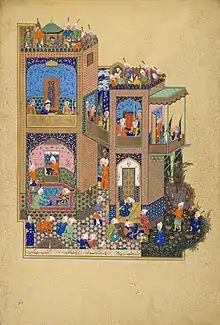 example of a Persian miniature, "The Nightmare of Zahhak" (c. 1525–1535)
example of a Persian miniature, "The Nightmare of Zahhak" (c. 1525–1535).jpg.webp) example of Tashir
example of Tashir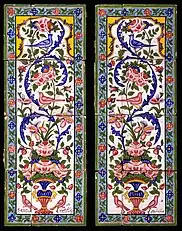 Gol o bolbol motif on earthenware tiles, from the Qajar-era
Gol o bolbol motif on earthenware tiles, from the Qajar-era Persian silk brocade with silver and gold thread, with paisley pattern
Persian silk brocade with silver and gold thread, with paisley pattern
Places in Iran to find handicrafts
- Grand Bazaar, Tehran
- Vakil Bazaar, Shiraz
- Bazaar-e Bozorg, Isfahan
- Tabriz Grand Bazaar, Tabriz
- Fire Temple of Yazd.
See also
References
- ↑ "Kapu of Khuzestan". www.visitiran.ir. Retrieved 2022-03-11.
- ↑ "توتن (قایق) یکی از صنایع دستی سیستان /دریاچه هامون چشم انتظار حیات دوباره آن است". Young Journalist Club (in Persian). Retrieved 2022-03-11.
- ↑ Beattie, M. (December 15, 1986). "Ardabīl Carpet". Encyclopaedia Iranica. Encyclopaedia Iranica Foundation. Retrieved 2022-03-11.
- ↑ "پاسداري از ميراث و گنجينه گرانبهاي صنايع دستي در منابع مكتوب | ایبنا" [Protecting the heritage and precious treasures of handicrafts in written sources]. خبرگزاری کتاب ايران (IBNA) (in Persian). 2010-06-10. Retrieved 2022-03-11.
- ↑ "Best Handicrafts of Iran: Souvenirs from the Past - Visit Our Iran - Discover Iran".
- ↑ Johnston, Amanda; Hallett, Clive (2014-02-03). Fabric for Fashion: The Complete Guide: Natural and Man-made Fibres. Quercus Publishing. p. 515. ISBN 978-1-78067-513-8.
- ↑ "نمدمالی کرمانشاهی، میراث معنوی ایرانی شد" [Kermanshahi felt became the spiritual heritage of Iran]. ایسنا (ISNA) (in Persian). 2013-01-31. Retrieved 2022-03-11.
- ↑ Sarshar, Houman M. (2014-09-17). The Jews of Iran: The History, Religion and Culture of a Community in the Islamic World. Bloomsbury Publishing. pp. 214–215. ISBN 978-0-85773-710-6.
- ↑ "Iranian handicrafts: Khameh-Duzi of Sistan-Baluchestan". Tehran Times. 2021-10-09. Retrieved 2022-10-07.
- ↑ Middle East and Indian Ocean. Société d'histoire de l'Orient. 1999. p. 348. ISBN 978-2-7384-8380-5.
- ↑ "A research on Shiraz's native art-industry condemned to oblivion". Allameh Tabataba’i University. 2023-09-09. Retrieved 2023-09-09.
Dovatgari
- ↑ سامانیان, ساسان; بهمنی, ساره (2022-03-21). "پژوهشی در دواتگری شیراز هنر-صنعت بومی محکوم به فراموشی". دو فصلنامه دانش های بومی ایران (in Persian). 9 (17): 149–176. doi:10.22054/qjik.2023.71081.1343. ISSN 2345-6019.
- 1 2 3 "Iranian handicraft; a rainbow of diversity rooted in old history". IRNA English. 2019-06-10. Retrieved 2022-03-11.
- ↑ The Cambridge History of Iran by I. Gershevitch (1985) p.154
- ↑ Meals, Roy A. (2020-10-20). Bones: Inside and Out. W. W. Norton & Company. p. 296. ISBN 978-1-324-00533-9.
- ↑ Journal of the Australasian Ceramic Society. Australasian Ceramic Society. 1989. p. 54.
- ↑ Crabtree, Pam J. (2008). Encyclopedia of Society and Culture in the Medieval World. Facts On File. p. 77. ISBN 978-0-8160-6936-1.
- ↑ Gh, Akbar (2017-11-25). "Siāh chādor (lett: black tent) is a type of curtain made from the goat hairs". Iran Cultura. Retrieved 2022-03-11.
- ↑ "Iranian MPs Authorize Formation of Handicraft Development Fund - Society/Culture news". Tasnim News Agency. July 5, 2017. Retrieved 2022-03-15.
- 1 2 Diba, Layla S. (2011). Turkmen Jewelry: Silver Ornaments from the Marshall and Marilyn R. Wolf Collection. Metropolitan Museum of Art. Metropolitan Museum of Art. ISBN 978-1-58839-415-6.
- ↑ "آشنایی با هنر تشعیر". همشهری آنلاین (in Persian). 2011-07-13. Retrieved 2022-03-11.
External links
Wikimedia Commons has media related to Handicrafts of Iran.
This article is issued from Wikipedia. The text is licensed under Creative Commons - Attribution - Sharealike. Additional terms may apply for the media files.